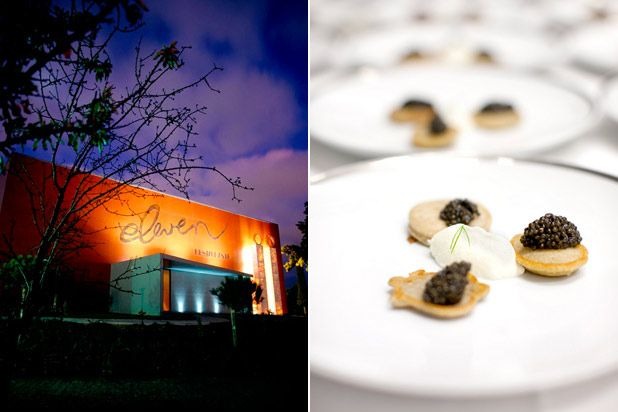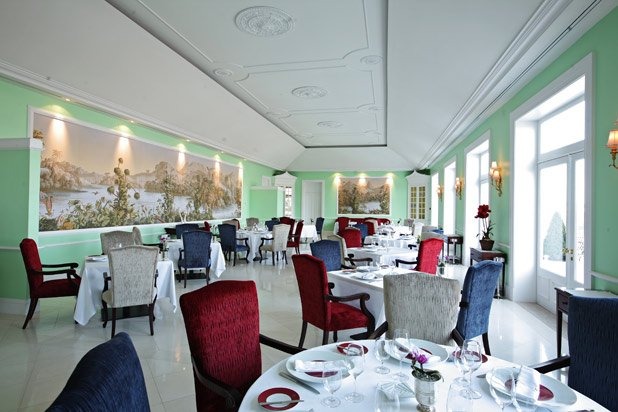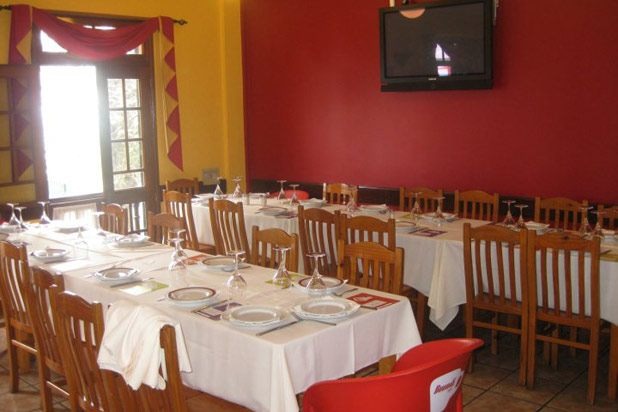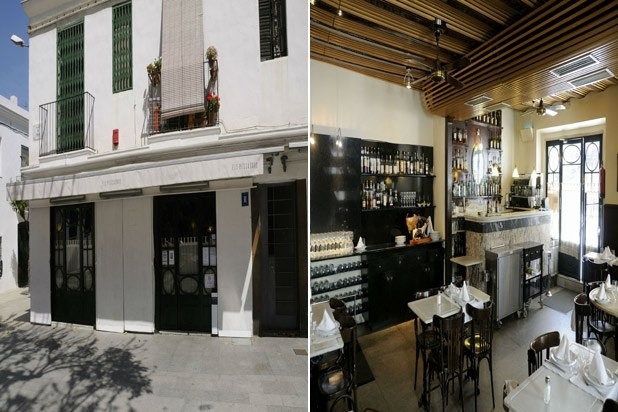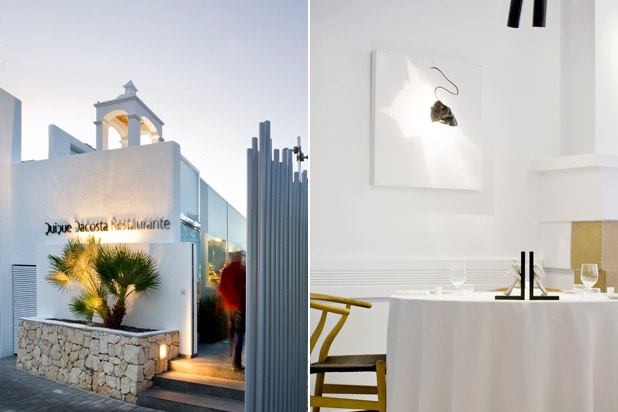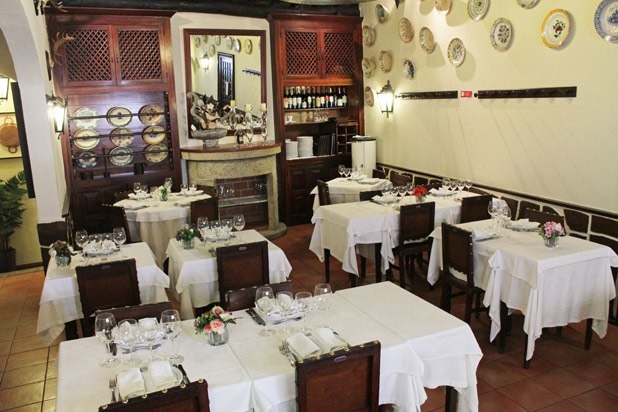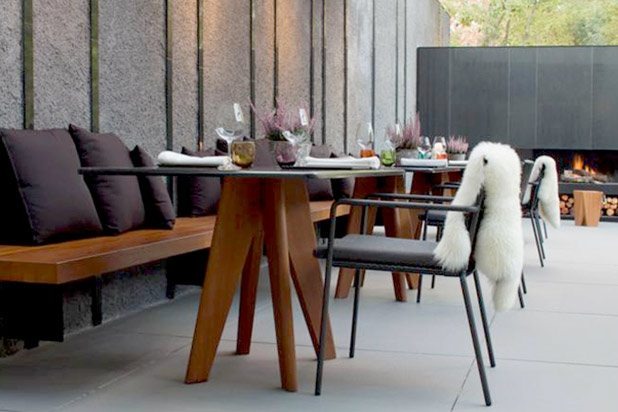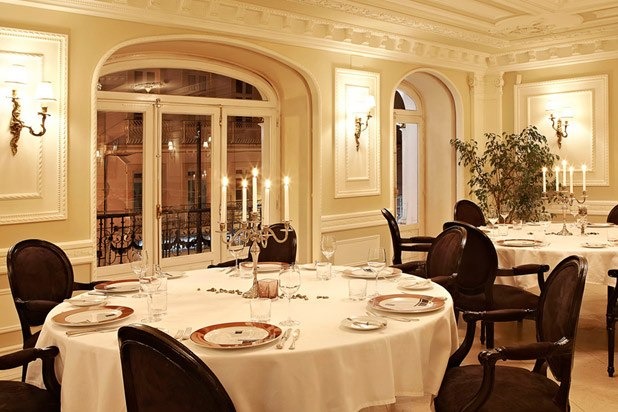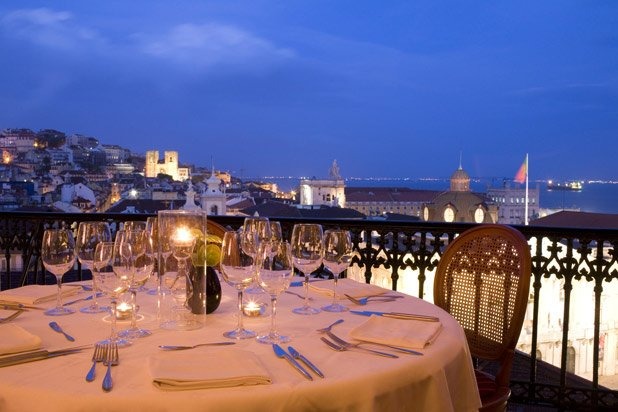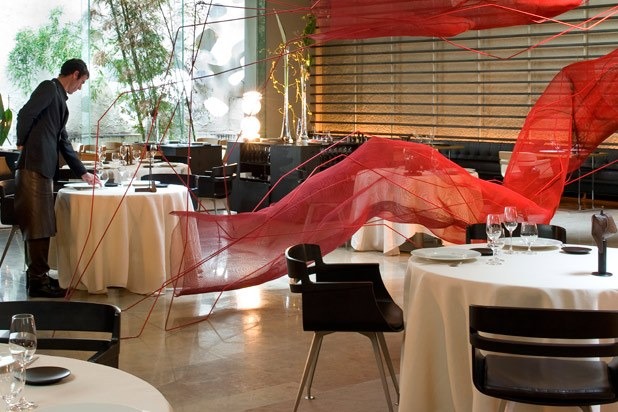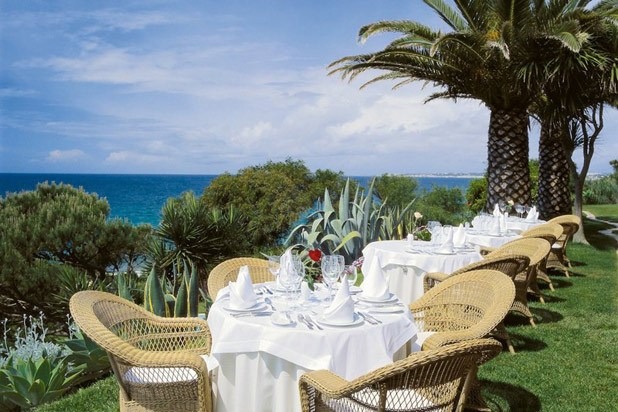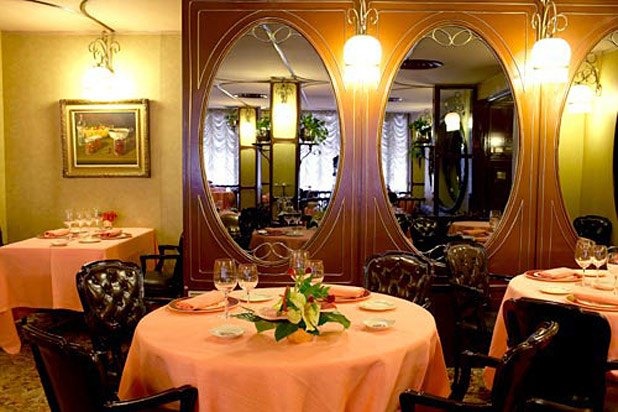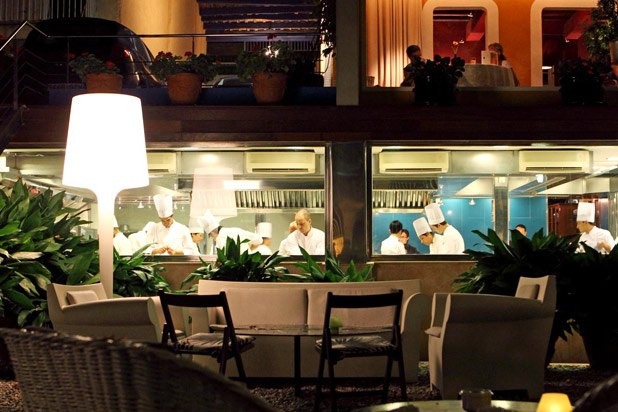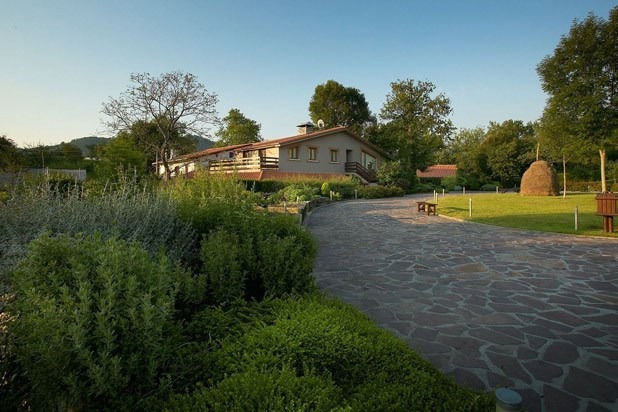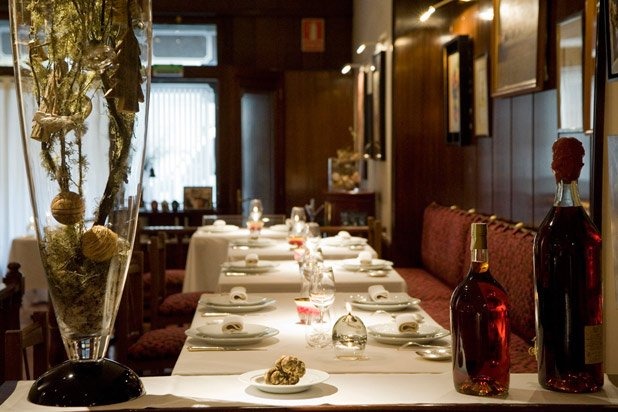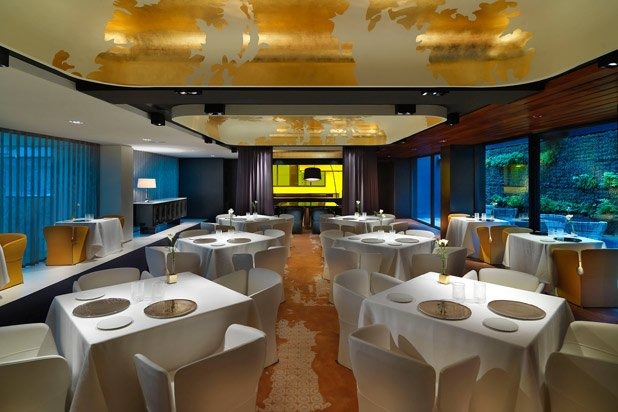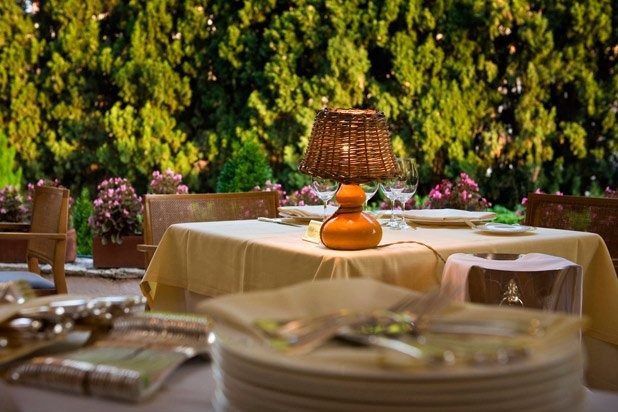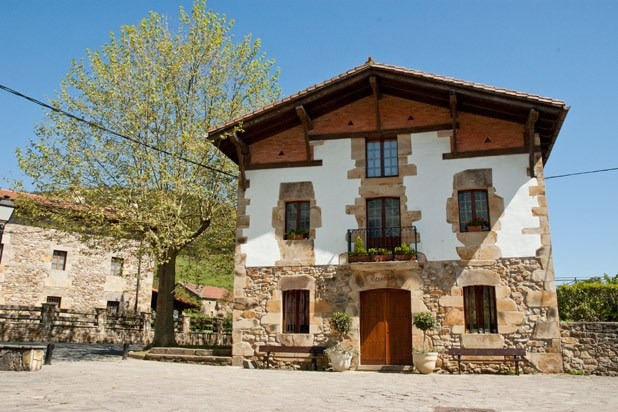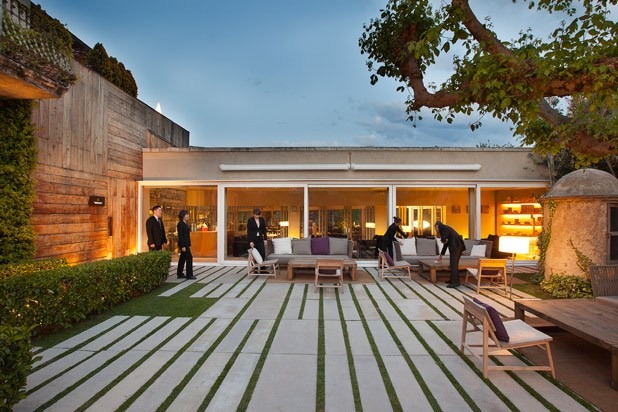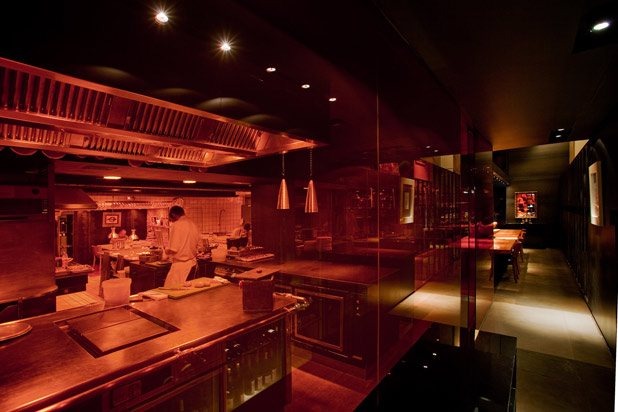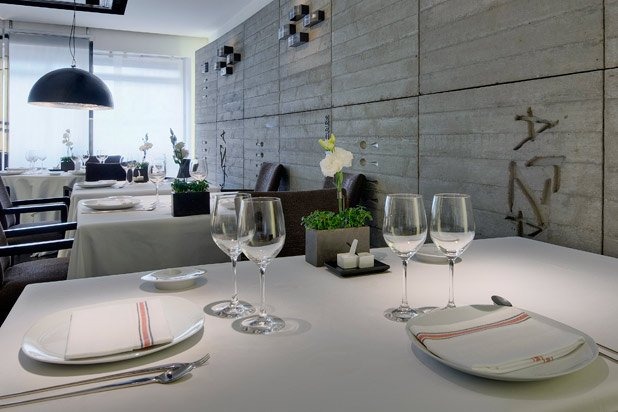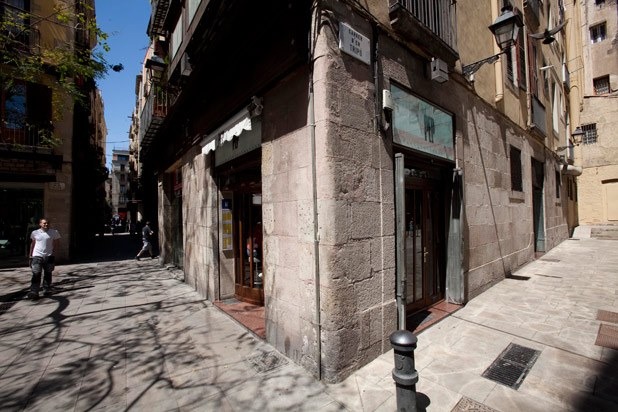25 Best Restaurants In Spain And Portugal
With its décor featuring blond wood, decorative stone, and large windows with sweeping views of Lisbon, Eleven is nestled in the Amália Rodrigues garden, former hideaway of the so-called Queen of Fado (the heart-rending traditional musical form of Portugal). The restaurant's minimalist aesthetic sets the stage for chef Joachim Koerper's elegant fare — foie gras terrine with tangerine jam, São Tomé chocolate, and honey crunch; lobster salad with artichokes, smoked ham, and confit olives; Azores red mullet with Mediterranean vegetables and tapenade sauce; "symphony" of black pork with potato and lemon gnocchi and carbonara sauce; quince millefeuille with Setúbal moscatel mousse and São Tomé vanilla ice cream...
24. The Yeatman (Porto, Portugal)
Overlooking the Douro River, the one-Michelin-starred restaurant within The Yeatman Hotel — which styles itself a "luxury wine spa" — offers traditional Portuguese cuisine with modern flair. Chef Ricardo Costa has created a menu focused on regional specialties and seafood, accompanied by wines, and or course ports, from a cellar with more than 1,000 labels. Though Costa often prepares complex dishes like marinated swordfish with vegetable carpaccio, crab cannelloni, and "molecular mozzarella" or black cod with a tomato crust, salt cod purée, and bivalve juices, his traditional Sunday roast is a highlight.
23. Taberna Típica Quarta-Feira (Evora, Portugal)
One of the most exemplary Portuguese taverns, Taberna Tipica Quarta-Feira — whose name means Traditional Tavern "Wednesday" — descends from an older place, Taberna do Pincel, and is full of old-fashioned charm. The menu offers simple, traditional dishes, many of them grilled, including lamb chops, veal loin and tenderloin, fried pork, and fresh cheese croquettes. The atmosphere is rustic and inviting, and the portions are ample.
22. Restaurante Zalacaín (Madrid)
In this era of "high-design" restaurant interiors and food that is often unexpected (and sometimes unsettling), it is a rare treat to find a calm, elegant place like this, where the only surprises are the perfection with which food is cooked and served. (Zalacaín was the first restaurant in Spain to earn three Michelin stars; today it has only one, but probably deserves two.) With its practiced staff — including one of Spain's great sommeliers, the deep-voiced Custodio López Zamarra — and its three lavishly decorated but homey (if you live in an elegant domicile) dining rooms, this is a place to enjoy such pleasures as oysters with caviar and sherry jelly, goose liver carpaccio with green olives and rosemary sauce, lobster with anchovy sauce and braised lettuce, veal loin in orange sauce, and the popular "chocolate volcano" — not to mention ever-perfect gazpacho and steak tartare.
21. Els Pescadors (Barcelona)
Though its name means "The Fishermen" in Catalan, and though Els Pescadors specializes in some of the best and freshest seafood in Barcelona, this slightly out-of-the way place in the city's beachside Poblenou neighborhood, which offers an old-school environment complete with marble tabletops and wooden beams and also a modern Mediterranean-style dining room, boasts a long menu of excellent food from both sea and land. Much of the food is straightforward and traditional, for instance seafood rice, grouper suquet (Catalan fish stew), salt cod with samfaina (the local version of ratatouille), and an array of simply grilled or griddled fish. There's some innovation here, too, though: foie gras "yogurt," marinated potatoes with smoked eel, black pasta with tuna and nori, duck leg with chocolate sauce, chocolate rusk with rosemary honey and lemon "cloud." If the weather's nice, sit outside on the historic Plaça del Prim; the restaurant likes to tell the story that when an Italian visitor was seated there one day, he looked around and exclaimed, "At last! The Mediterranean!"
20. Quique Dacosta (Dénia, Spain)
Probably the least known of the top Spanish avant-garde chefs, and one of the most daring, Dacosta combines traditional Spanish ingredients (red shrimp, eel, piquillo peppers, jamón, etc.) with such unexpected materials as oak bark, eucalyptus essence, and rompepiedra, a medicinal herb called stonebreaker in English, to create what he calls his "eco-cuisine" — a kind of edible landscape of the Costa Blanca, the southern Mediterranean littoral where his establishment is located. The restaurant became Spain's newest Michelin three-star restaurant in 2012. Visitors to his elegant restaurant, situated in a traditional Valencian-style house, updated with frosted glass and contemporary art, will enjoy such unexpected offerings as consommé of Ron Barceló rum barrels, seaweed in garlic sauce, cuttlefish turnover with lime and wasabi, and shrimp "tea" with chard, and Dacosta's squab in seven forms — roasted, sautéed liver, on flatbread, breast on herb sprouts, consommé, in rice with licorice and oranges, and with mango chutney — is a showstopper.
19. Fialho (Evora, Portugal)
What started as a simple chophouse in 1948 founded by Manuel Fialho has evolved into a much loved and admired Portuguese restaurant run by Fialho's children. The Fialho menu, created by Gabriel Fialho, features traditional dishes from Alentejo like oven-baked lamb, wild boar tenderloins with apple purée, pork loin with clams, and pigeon rice.
18. Ca l'Enric (La Vall de Bianya, Spain)
At this attractive restaurant in La Vall de Bianya, in Catalonia's Garrotxa region, inland from the Costa Brava, chef Joan Juncà and his siblings serve food full of personality and flavor, accompanied by superbly chosen wines (many from Catalonia, and especially from the fast-rising Empordà denominación, whose borders begin not many miles away) in a beautifully decorated dining room that is both rustic and sophisticated in appearance. Appropriately to its mountain locale, Ca l'Enric makes ample use of wild mushrooms, wild game, and mountain herbs. A reimagined omelette filled with the delicate mushrooms called camasecs (Marasmius oreades to mycologists) is a vivid example of Juncà's skill, as is an unusual preparation of rice with wild rabbit and white truffles — and there can be few chefs in Spain who are more masterful at the proper preparation of woodcock, that most precious and delicious of game birds. Boneless baby goat roasted with honey and thyme is another masterpiece. But the coast isn't too far away, and Juncà handles seafood very well, too, as with white asparagus soup with mussels and ham or monkfish with green onions. Ca l'Enric is a mountain hideaway worth discovering.
17. Tavares (Lisbon)
For more than 200 years, Tavares has been a meeting place for aristocrats and high society. It started out as a humble café in 1784, and was taken over in the 19th century by brothers Anthony and Manuel Tavares, who elevated the cuisine and turned the place into the premier restaurant in Lisbon. French-born Aimé Barroyer, who worked with Paul Bocuse among other culinary luminaries, embraces Portuguese traditions while cooking with Gallic finesse. His specialties include duck foie gras with eel, loquat, and sansho pepper; rabbit with snails, green beans, olives, and pine nuts (or with blue lobster and clams); and a mixed seafood dish of two kinds of mackerel, shrimp, and mussels.
16. Tágide (Lisbon)
In this comfortable restaurant housed in an 18th-century building overlooking Lisbon's old quarter and the Tagus River, chef Luis Santos serves daily changing à la carte and fixed-price menus that might include such dishes as open wild mushroom lasagna with dehydrated farinheira (a smoked flour and pork fat sausage), crawfish with classic sauce Nantua and green asparagus, Azeitão cheese parcel with grapes and tomato relish, and coconut pain perdu with rum, pineapple, and mint ice cream.
15. Moo (Barcelona)
This is the Roca brothers' second restaurant — Joan, Josep, and Jordi's first one, El Celler De Can Roca in Girona, has been called the second-best restaurant in the world (after Noma). Moo, located in Barcelona's Hotel Omm, with a kitchen under the direction of chef Felip Llufriu, features several tasting menus, with optional wine pairings, but there's also an à la carte menu offering such unexpected delights as smoked pigeon carpaccio with juniper ice cream; sea bass with yogurt, soy, and cumin; lamb shoulder with baked garlic purée and manchego cheese; and one of Jordi Roca's spectacular dessert creations: Trip to Havana — rum sponge cake, lime soup, peppermint granite ice, and cane sugar, with "frozen cigar Partagás Serie D No. 4 with spice ash."
14. Vila Joya (Albufeira, Portugal)
Overlooking the beach of Praia da Galé, the boutique hotel Vila Joya boasts Portugal's only Michelin-two-star, Vila Joya Restaurant. Austrian chef Dieter Koschina has helmed the kitchen since 1991, creating masterful and memorable haute cuisine using fresh lobster, turbot, and other delicacies from the Atlantic and the Mediterranean, along with fresh produce from local markets. His imaginative specialties include giant prawns with calf's head vinaigrette; duckling with goose liver, lentils, and celery ravioli; and a "hot and cold" composition of Valrhona chocolate.
13. Via Veneto (Barcelona)
Its very Roman name notwithstanding, there's nothing Italian about this old-time luxury restaurant. And its faux-art nouveau décor and preponderance of black leather accoutrements aside, it isn't a place that trades on nostalgia. In fact, chef Carles Tejedor is one of the bright lights of Barcelona's contemporary food scene. His cuisine is modern and imaginative, with international accents, but always full of intense, pure flavors. Try his watermelon gazpacho with salt cod and baby clams, his lobster tartare with salmon caviar and sour cream sauce, his bamboo-steamed hake in a couscous crust, his rice with baby octopus and chicken giblets, his roasted baby chicken with walnut bread — and add Tejedor to the lists of young chefs who are proving that the future of good cooking in the Catalan capital is in good hands.
12. Rafa's (Roses, Spain)
There is a handsome-looking jamón Ibérico in a holder on the counter, and there are rumors that sometimes fish soup, gazpacho, and maybe asparagus are served, but what Rafael "Rafa" Cantero mostly does in his tiny restaurant on a backstreet in the seaside town of Roses is to cook fish and shellfish in olive oil a la plancha, on the griddle, seasoned with nothing more than salt and their own impeccable freshness. The menu is verbal, but typically includes things like shrimp, crayfish, clams, tiny squid, larger squid, sole, lemon sole, John Dory, sea bass, monkfish, scorpionfish, and three or four others kinds of seafood. Have a half-and-half order of shrimp and crayfish — big, salty, perfectly (under)done — and then a lemon sole, and you'll know what pure good food tastes like. If you understand the philosophy behind the very different cooking of Ferran Adrià, you might even see why this is one of his favorite places to eat.
11. Sant Pau (Sant Pol de Mar, Spain)
Chef Carme Ruscalleda's Sant Pau in Sant Pol de Mar, a half hour north of Barcelona, is a three-Michelin-starred affair where she serves a tasting menu whose dishes change with the seasons. Ruscalleda, regarded as one of Spain's leading female chefs, serves a cuisine that while based on Catalan traditions, is open to global influences (her second restaurant, which has two Michelin stars, is in Tokyo). With dishes like "autumnal cod brandade with daikon, green pepper, black sausage, and spinach" or "king prawn with tomato, and strawberry velvet" you should expect some poetry, but don't be fooled: Ruscalleda's food, while soulful, is prepared by a technical master.
10. Mugaritz (San Sebastián, Spain)
elBulli has closed, but the reach of its influence will only continue to be demonstrated in the years to come both in Spain and around the world. One such example exists on the other side of Spain from Roses, in Errenteria in the hills above San Sebastián. At Mugaritz (a former dairy), one of Ferran Adrià's apprentices, chef Andoni Luis Aduriz, has carved out a reputation of his own, winning two Michelin stars and occupying a place on San Pellegrino's list of The World's 50 Best Restaurants for seven years. Explains their restaurant of their name: "Our haritza ("oak" in Basque), is strategically situated beside the line dividing Errenteria and Astigarraga. Thus, this tree delimitates the muga (frontier) between both towns. Muga eta haritza. Mugaritz." Edible stones, homemade mozzarella with whey emulsion infused with rock tea — as at elBulli, you'll be putting yourself in the hands of the chef, surrendering yourself to a tasting menu formulated on its nonconformity and melding of science, food, emotion, and magic.
8. Ca l'Isidre (Barcelona)
Isidre Gironès is a veteran Barcelona restaurateur, but still goes to the markets himself every morning and still shoots game birds in season that will end up on his table. His is an old-style restaurant, small, comfortable, and woody, with a mostly traditional menu offering some of the best jamón in town, the raw Catalan salt cod salad called esqueixada, soupy rice with seafood, beef fillet in port sauce, and the like. Some less common choices might be whole ceps roasted in foie gras fat in parchment (do not miss them if they're available), langoustine ravioli with ginger and lime, pig's foot stuffed with mushrooms and truffles, and yogurt foam with raspberries and strawberries. Come to Ca I'lsidre for the old-fashioned virtues of consistent cooking, excellent service, and an overall feeling of well-being.
7. Tickets/41º (Barcelona)
This two-part tapas emporium in the heart of Barcelona's old theater district keeps the spirit of elBulli alive. That's not surprising since it's run by Albert Adrià, doubtless with behind-the-scenes advice from his brother, Ferran. And of course "tapas" has a special meaning here: At Tickets, which is a bustling, bright, colorful, humorously furnished place — part Vaudeville, part Vegas, part seaside amusement park — it is possible to have superlative jamón, anchovies, and other straightforward tapas, but then there is such Adriana as eggs fried in duck fat with black truffles and potato cream, oysters with a seawater pearl, avocado "canelón" with crabmeat and romesco sauce, and black sesame stones with white chocolate. Next door, the black-and-red-hued 41º is an avant-garde cocktail bar with snacks from midnight onwards — but earlier in the evening, some 16 lucky diners a night can enjoy the "41º Experience" — a non-stop tapas menu of about 50 little bites, many of them very close to things you might have been served at elBulli. Expect the unexpected: tiny artichokes in anchovy emulsion beneath a snowfall of breadcrumbs and Parmigiano, smoked eggplant with hazelnut caviar and real caviar (and a shot of hazelnut vodka), eel with daikon and black garlic, creamy Torta Cañarejal cheese with black truffles and honey meringues... and on and on and on.
6. Moments (Barcelona)
This small, attractive dining room in Barcelona's Mandarin Oriental Hotel is under the direction of Raül Balam, whose mother (and consultant in this project) happens to be Carme Ruscalleda, who has three Michelin stars at her Sant Pau restaurant in Sant Pol de Mar; and another two for her restaurant in Tokyo. With its ample white-napped tables, gold ceiling, and window onto a wall of greenery, this is an oasis of calm in the midst of a busy city. The menu, following a series of "micro" appetizers, offers such dishes as espardenyes (the sea cucumber much prized on the Catalan coast) with white bean cream and cauliflower foam, crawfish with pistachio sauce and green beans, red mullet with beluga lentils and dill cream, roasted veal cheeks with shallots and pineapple chutney, and a Japanese-inspired dessert of fresh cheese with blueberries and caramelized flowers — everything superbly crafted.
5. El Motel Restaurant (Figueres, Spain)
Modern Catalan cuisine was born in the kitchen at this modest roadside inn on the highway between Figueres and the French border, created by the late Josep Mercader. Mercader's son-in-law, Jaume Subirós, continues the tradition, serving an ever-changing catalogue of savory dishes both traditional and invented in the hotel's handsome, unpretentious dining room. (The restaurant's name is a tribute to its origins: Mercader dubbed his hostelry the Motel Ampurdan. It has been ungraded and its name has been translated into Catalan so that it is now the Hotel Empordà. Because local gourmets got into the habit of saying "Let's go to the motel," Subirós decided several years ago to rename the dining room in honor of the place's beginnings.) The quality of ingredients here is impeccable, and there is no better place to sample straightforward preparations like ceps sautéed with garlic and parsley or a typical Empordanese dish of local duck with pears. But diners here should also sample versions of some of Mercader's celebrated inventions, like grilled salt cod with garlic mousseline, as well as dishes created by his successor, like a wonderful warm terrine of pigs' feet and snails or a bright dessert of raspberries gratinéed with garnacha sabayon.
4. Asador Etxebarri (Axtondo, Spain)
Bittor Arguinzoniz grew up grilling; it's the basic Basque means of cooking. In the little mountain town where he was born, he keeps grilling, but his imagination and skill at what some people wrongly believe to be a simple culinary medium have turned his restaurant into a gastronomic shrine. Using embers from several types of wood that he has burned down himself each morning, Arguinzoniz grills everything: not just the expected things, like big Mediterranean shrimp, gorgeous slabs of beef, and game birds, but even sea slugs from the Costa Brava (called espardenyes), delicate wild mushrooms, and caviar. Everything takes on a faint hint of smoke but is perfectly done and irresistible.
3. El Celler de Can Roca (Girona, Spain)
Considered the heir apparent to the now-closed elBulli as the leader in avant-garde cuisine in Catalonia, this superb restaurant (number two in the world, after Noma in Copenhagen, according to Restaurant magazine) grew out of a simple tavern run by the Roca brothers' parents. The three young men — chef Joan, pastry chef Jordi, and wine expert Josep — learned their craft both from their family and from some of the finest forward-thinking chefs in Spain (Ferran Adrià among them). Today, in their beautiful establishment, clean-lined and bright in an almost Scandinavian way, they offer exquisite, unusual food — from caramelized olives brought to the table on a bonsai-size olive tree to oysters marinated in fino sherry with seaweed and oyster sauce to sole with olive oil emulsions of olive, pine nut, orange, bergamot, and fennel to steak tartare with mustard ice cream — guaranteed to amaze and delight. Desserts are miniature sculptures (a tiny tower that turns out to be rose soufflé with lychee sorbet foam), and the wine list is extraordinary — though not as extraordinary as the themed chambers of the wine cellar, a must to visit.
2. El Racó de Can Fabes (Sant Celoni, Spain)
Santi Santamaria, the self-taught Catalan chef who turned a corner of his family's small-town farmhouse into his region's first Michelin three-star restaurant, died suddenly of a heart attack in early 2011, in Singapore, where he was opening an opulent outpost of his growing restaurant empire. It is no disrespect to him — quite the contrary — to say that the quality of Can Fabes, still run by Santamaria's widow, Àngels Serra, and his family, hasn't faltered. This is due in large part to the presence in the kitchen of Xavier Pellicer, a onetime Can Fabes chef who went on to cook dazzling food at ABaC in Barcelona before returning here, shortly before Santamaria's demise. Santamaria opposed so-called molecular gastronomy, but the food at Can Fabes is full of imagination while remaining firmly Catalan. Choose between a contemporary and a rustic dining room and sample asparagus with saffron sabayon and baby octopus; peas with blood orange vinaigrette; razor clams with favas, cock's combs, and gizzards; Pyrénean lamb with goat milk gnocchi; local strawberries with basil and verbena ice cream...
1. Arzak (San Sebastian, Spain)
With his cohort Pedro Subijana of Akelaré, Juan Mari Arzak brought nouvelle cuisine to the Basque Country, and helped modernize restaurant kitchens all over Spain. He is still a master, producing finely crafted traditional food on occasion but also embracing new techniques and fashioning innovations of his own at Arzak. And he now shares cooking duties with an even more modern-minded chef, his daughter Elena — the fourth Arzak generation to cook in this same spot. Expect dishes like rockfish mousse wrapped in fried noodles, lobster in a crispy potato shell with a sauce based on an the pith of an oily South American tree called copaiba, monkfish with spelt and gooseberries, duck leg with hibiscus pudding, and roe deer with hot chile sauce.
9. Cal Pep (Barcelona)
Nestled in a small square just north of the Plaça de Palau since 1977, Cal Pep (run by chef and owner Josep "Pep" Manubens Figueras) is synonymous with the great tapas and seafood of Barcelona.The restaurant is tiny bar seating only so pay close attention to the time.If you show up when they open, you'll be waiting more than a full turn to be seated (the trick is to go for lunch and get there 15 minutes before they open at 1 p.m. remember that they're not open for lunch on Monday, though). When you do get it, they'll ask meat, seafood, or vegetable. Say, all of the above and eat everything they give you from the open kitchen. Do make sure you taste the razor clams, the fried artichokes, and frito misto (Pep has a special talent for frying), and the vastly underrated tortilla Espaola, a creamy potato and egg omelette speckled with onion and spicy bits of chorizo. (New Yorkers take note, this is supposedly where Mario Batali and Joe Bastianich went for inspiration for their perennially crowded restaurant Casa Mono.)
